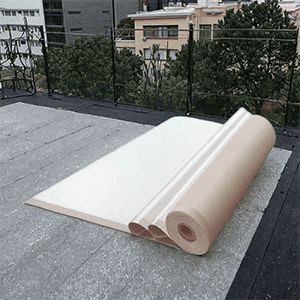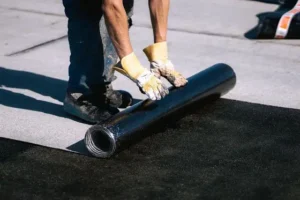The TPO (Thermoplastic Olefin) Waterproof Membrane has become a widely accepted method of waterproofing commercial and residential buildings, not only due to its environmental factors but also its cost efficiency and durability. Still, a dominant concern for many building contractors and owners is, What is the durability of TPO waterproof membrane?
This is what this article aims to address: to analyze the lifespan of TPO membranes, alongside an exploration of the various contributing factors such as installation, maintenance, and material quality that affects how long one can reasonably anticipate this membrane enduring.
1. What Is TPO Waterproof Membrane?
TPO stands for Thermoplastic Polyolefin and is classified as a single-ply roofing membrane consisting of a mixture of polypropylene and ethylene-propylenerubber. The primary factors attributing to TPO’s surging popularity are its efficiency for commercial purposes, i.e., highly flat and low-slope roofing, thermal resistance, and strong reflection of sunlight. Now, it is not uncommon to find it in residential buildings alongside commercial and industrial structures.
2. Average Lifespan of TPO Membrane
Applying proper maintenance practices to a high-quality TPO waterproof membrane can extend its durability up to 15- 30 years. Nonetheless, that may not always be the case, and as will be elaborated on in the following sections, there are other determining factors that significantly affect this es
3. Factors Affecting the Lifespan of TPO Waterproof Membrane
Several factors can impact the longevity of TPO membranes. Understanding these elements can help ensure you get the maximum service life out of your membrane.
- Quality of the Membrane: Not all TPO membranes are created equal. High-quality membranes, such as those with reinforced fabrics or UV inhibitors, tend to last longer. When choosing a TPO membrane, it’s important to opt for products from reputable manufacturers that meet or exceed industry standards.
- Installation Quality: Proper installation is crucial for maximizing the lifespan of TPO membranes. Poor installation, such as improper sealing of seams or lack of adequate preparation of the substrate, can lead to premature membrane failure. Always hire a professional contractor with experience working with TPO systems.
- Environmental Conditions: TPO membranes are designed to withstand various environmental challenges, but extreme weather conditions can still impact their durability. Areas with intense UV exposure, heavy rainfall, high winds, or fluctuating temperatures may see a reduction in lifespan. Proper maintenance and periodic inspections can help mitigate these effects.
- Maintenance and Care: Regular maintenance plays a significant role in extending the life of your TPO membrane. Keeping the surface clean and free of debris, repairing small damages promptly, and inspecting seams and flashing areas will all contribute to longer-lasting performance.
- Foot Traffic: Frequent foot traffic on TPO roofs can wear down the membrane over time. If the roof is regularly accessed, installing walkways or protective pads can reduce wear and tear.
4. How to Extend the Lifespan of Your TPO Waterproof Membrane
While TPO membranes are durable, there are several steps you can take to ensure they last as long as possible:
- Regular Inspections: Perform annual or bi-annual inspections of your TPO membrane to check for any damage, such as punctures, tears, or loose seams. Early detection and repairs can prevent more extensive damage.
- Cleaning: Regularly cleaning the surface of the TPO membrane helps prevent the buildup of dirt, algae, and other substances that can degrade the material. Using a mild detergent and water solution is usually sufficient.
- Prompt Repairs: If you notice any signs of damage, such as cracks or tears, it’s essential to repair them immediately to prevent moisture infiltration and further deterioration.
- Avoid Harsh Chemicals: Avoid using harsh chemicals on your TPO membrane, as these can cause damage. Stick to cleaning agents that are recommended for TPO roofing systems.
5. Signs That Your TPO Membrane Needs Replacement
Even with proper care, no roofing material lasts forever. Here are some signs that it may be time to replace your TPO waterproof membrane:
- Visible Cracking or Blistering: If you notice cracks, blisters, or brittleness in the membrane, it could be an indication that the material has reached the end of its useful life.
- Water Leaks: Persistent leaks, especially after repairs, may indicate that the membrane has lost its ability to provide an effective waterproof barrier.
- Discoloration and Wear: Significant discoloration or excessive wear on the surface can be signs that the TPO membrane has been exposed to UV radiation or environmental stress for too long.
6. Conclusion
TPO waterproof membranes are a reliable and long-lasting solution for flat and low-slope roofs. With an average lifespan of 15 to 30 years, they offer excellent performance when installed and maintained properly. By choosing high-quality materials, ensuring proper installation, and performing regular maintenance, you can extend the lifespan of your TPO membrane and protect your building from water damage.
Investing in TPO membranes means a lower total cost of ownership over time, along with energy savings and environmental benefits. Whether you’re considering a new installation or maintaining an existing TPO membrane, the proper care will ensure that your roof continues to provide reliable protection for many years to come.
If you’re looking for high-quality TPO waterproof membranes, contact HUAFENG WATERPROOF MATERIALS CO., LTD., and let us help you choose the best solution for your waterproofing needs!

For more information or to inquire about our waterproof floor paint solutions, feel free to get in touch with us. We’re here to help!
- Phone: +86 138 6365 6701
- Email: Huafengwaterproof@gmail.com
- WhatsApp: +86 138 6365 6701
We look forward to assisting you with all your waterproofing needs!






